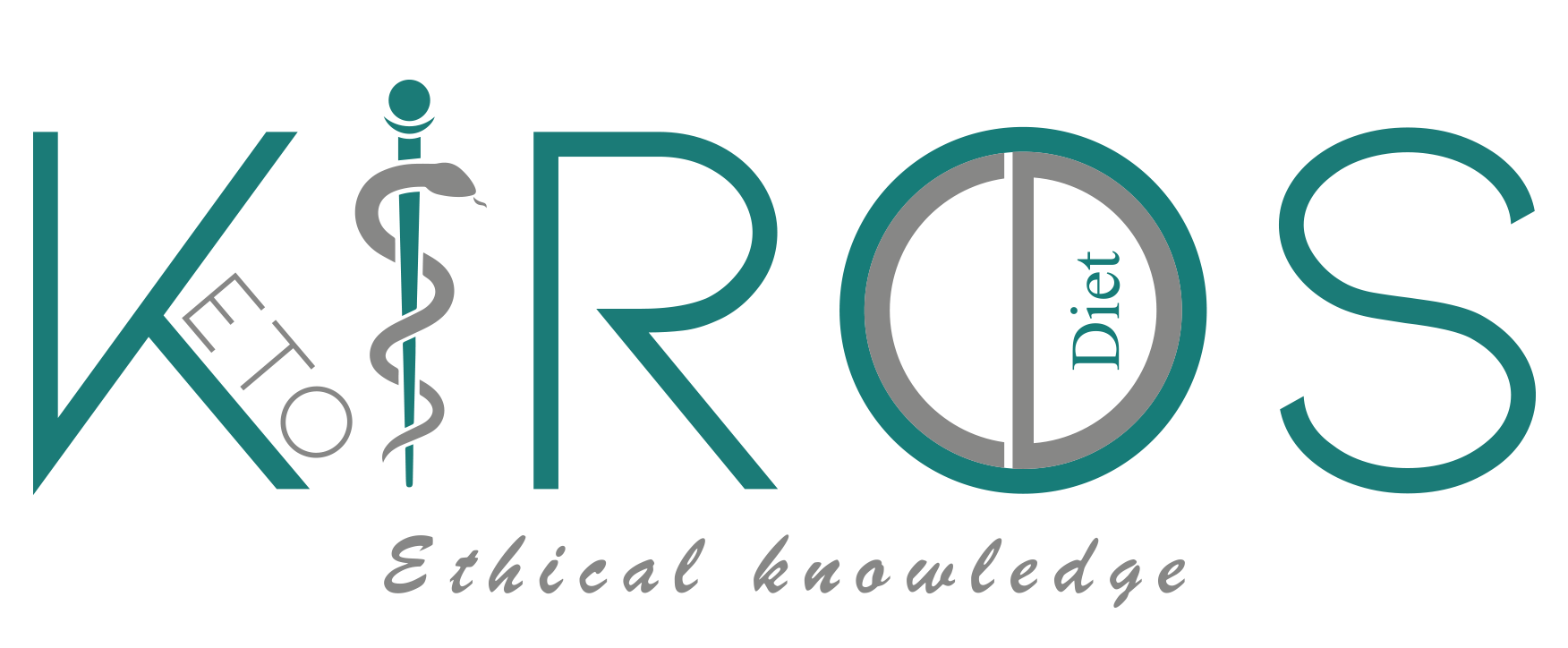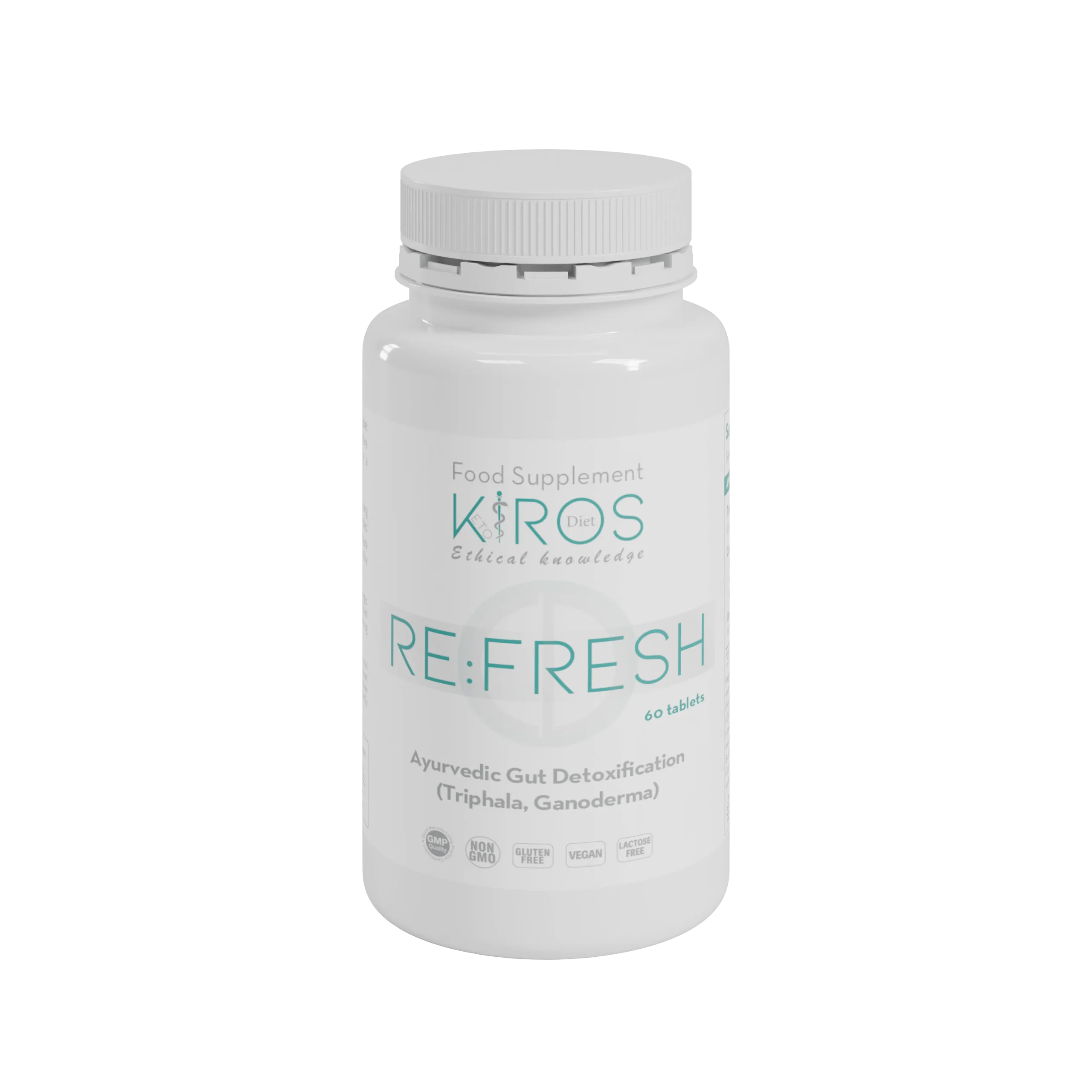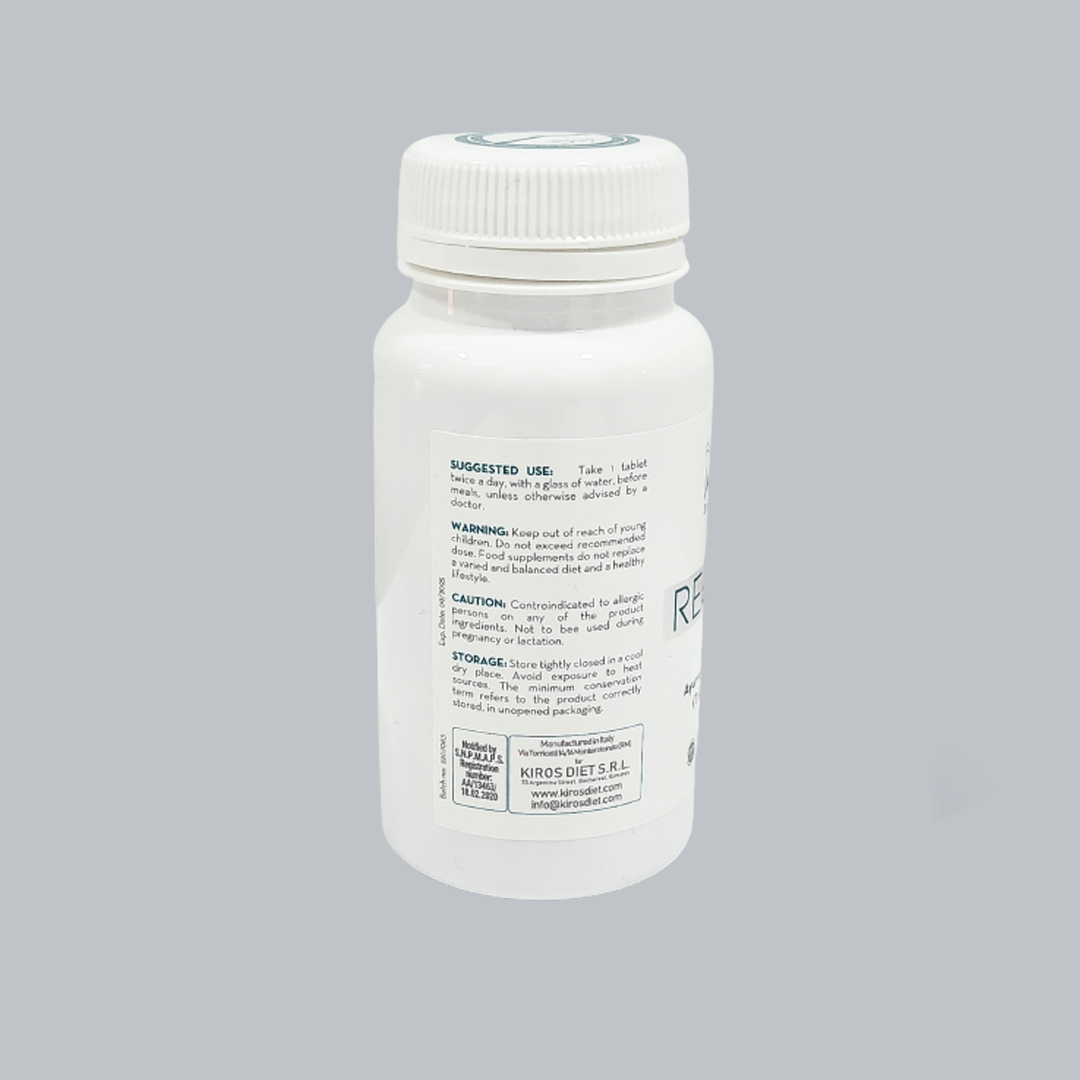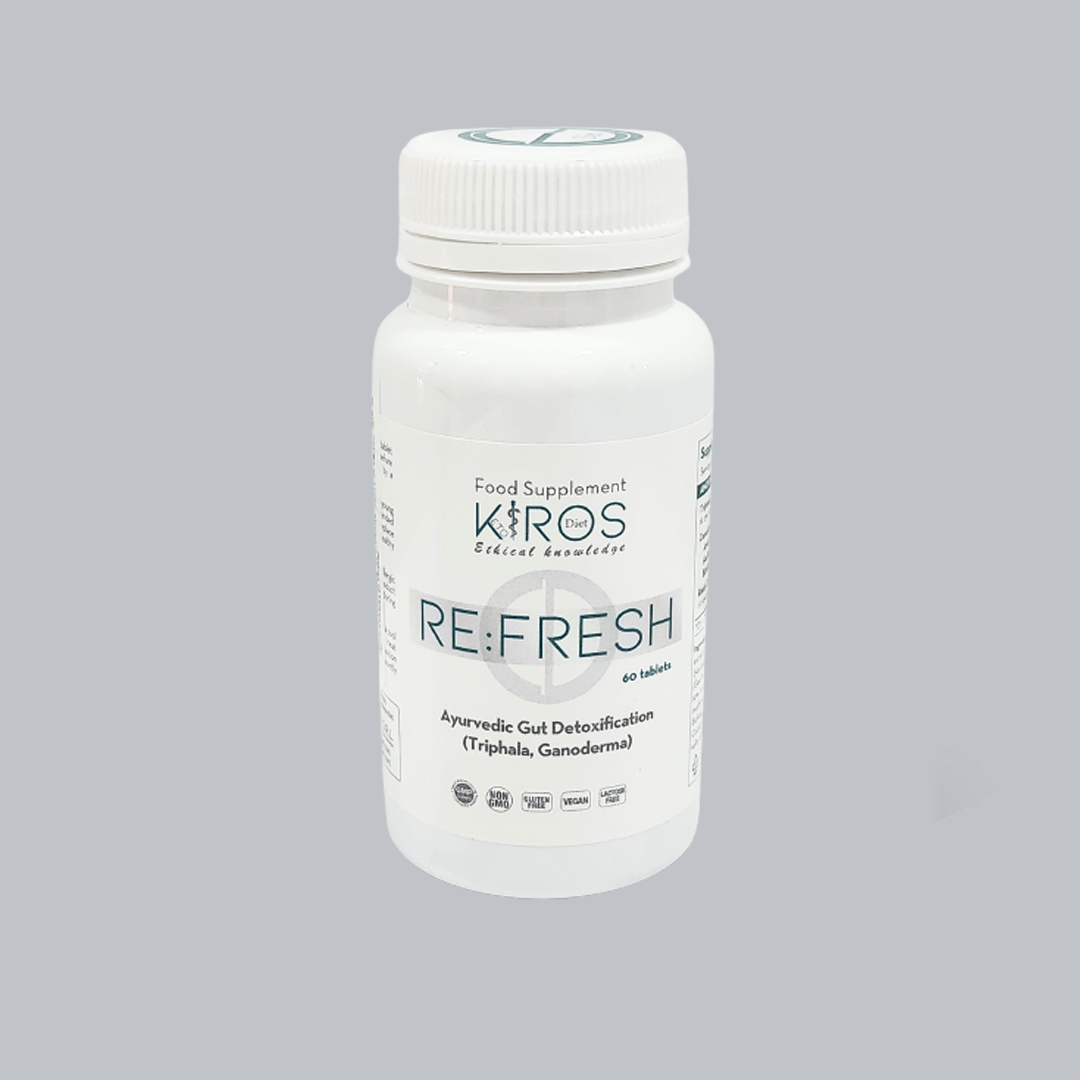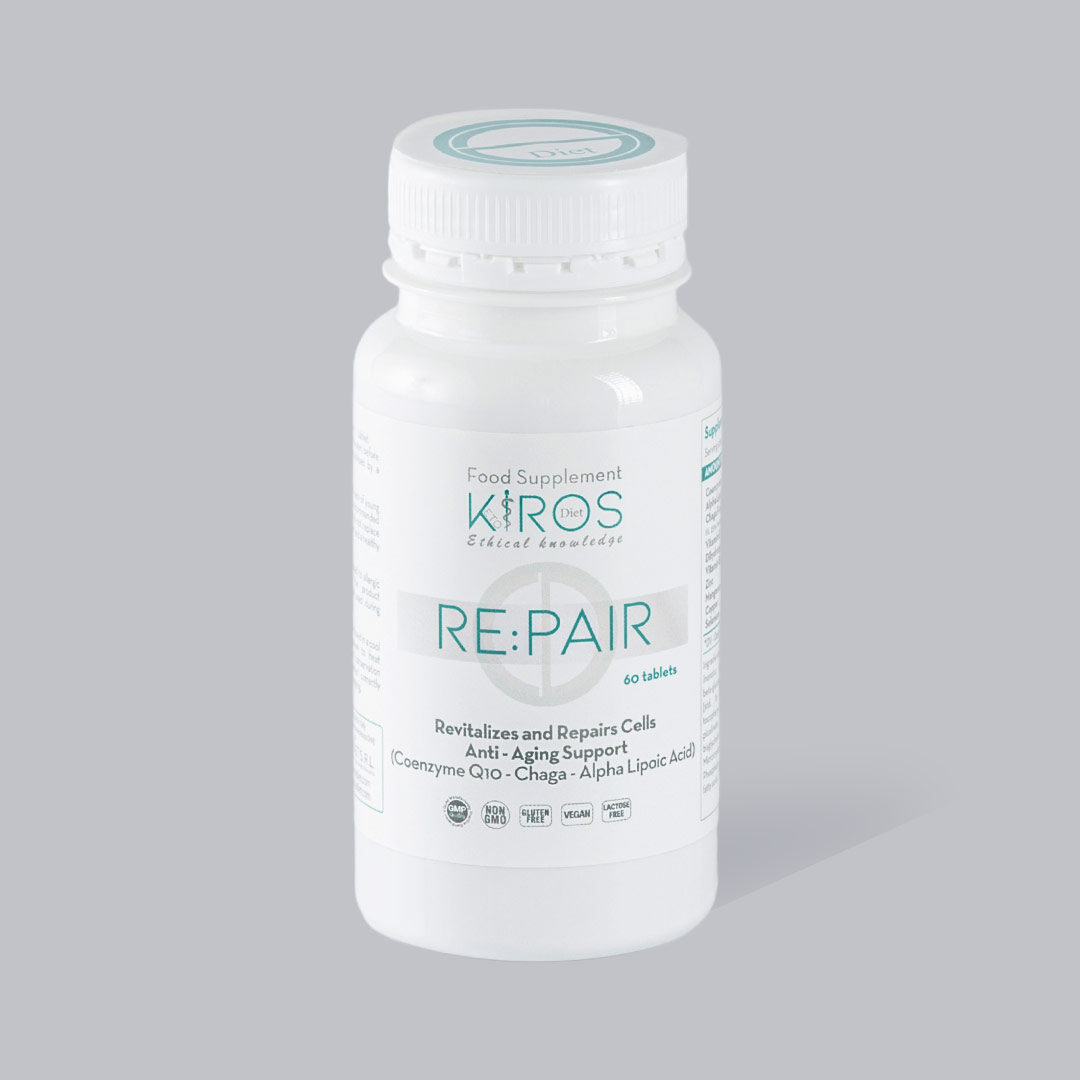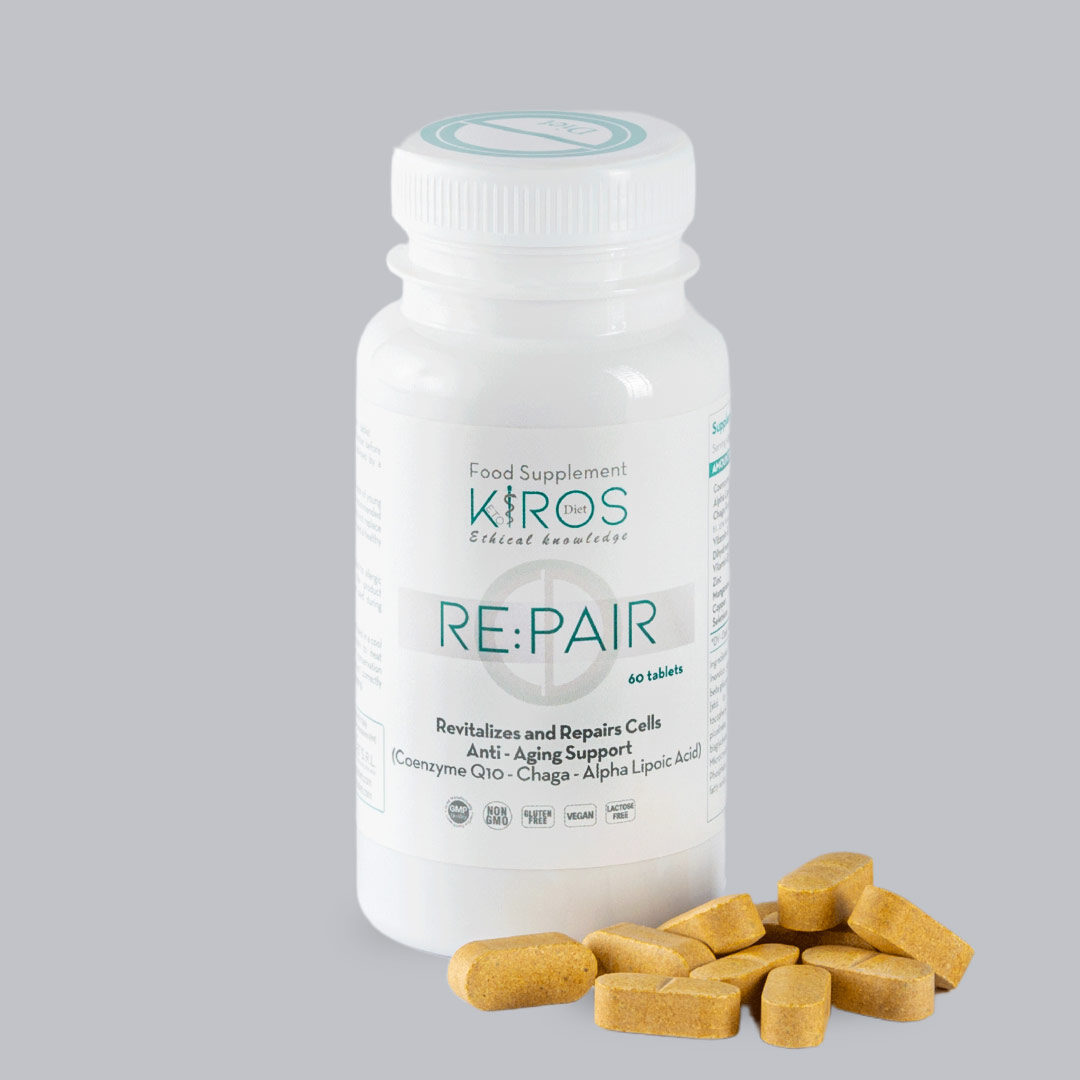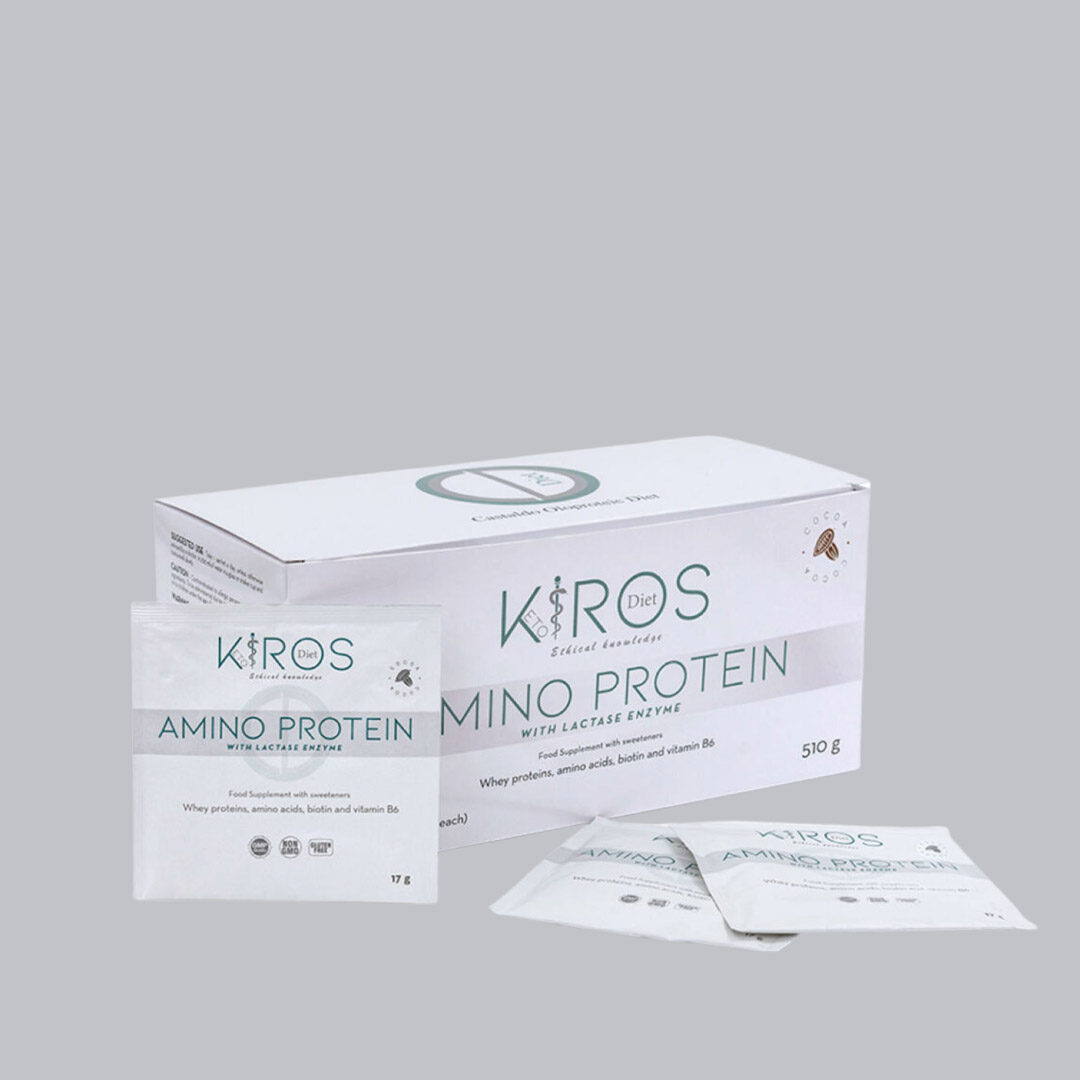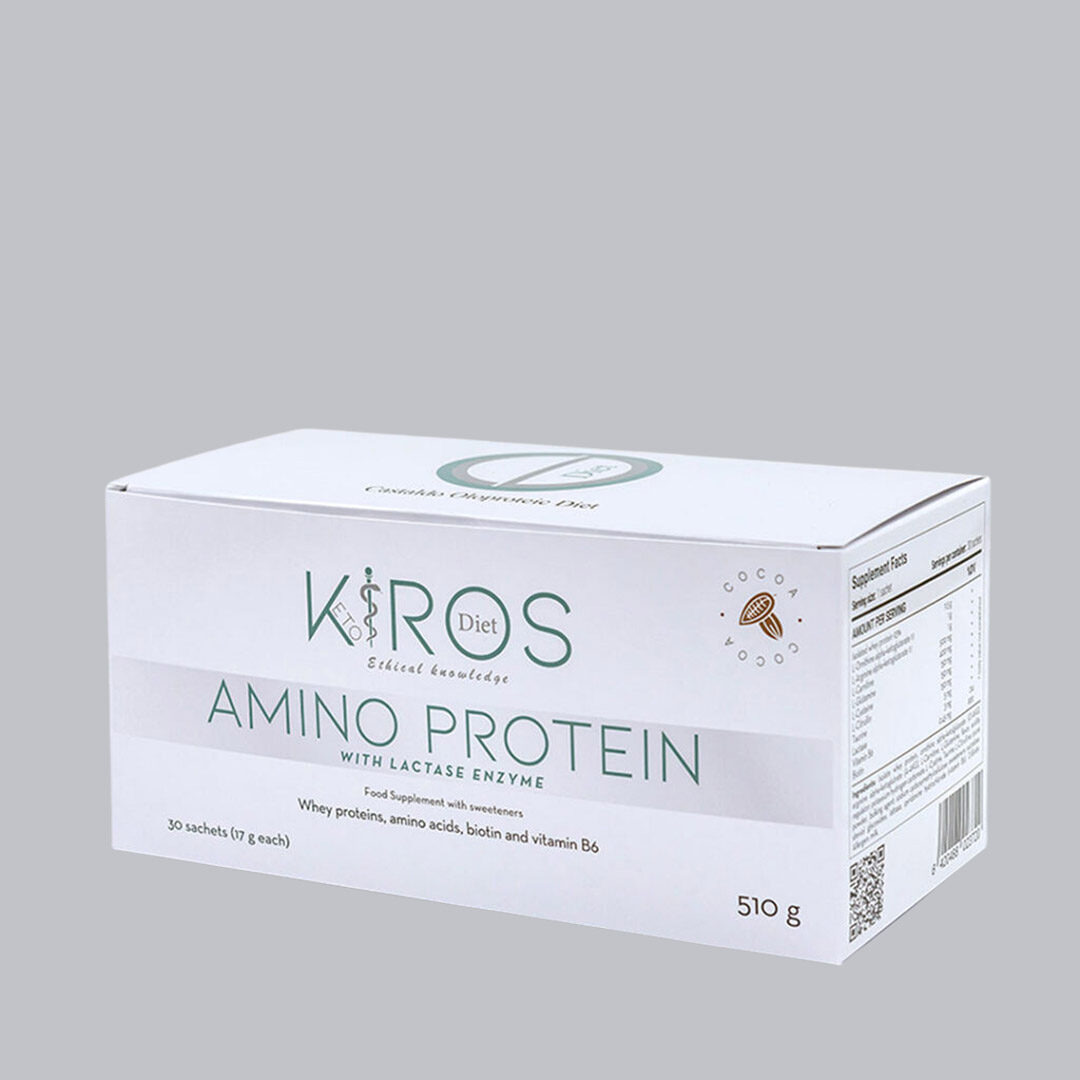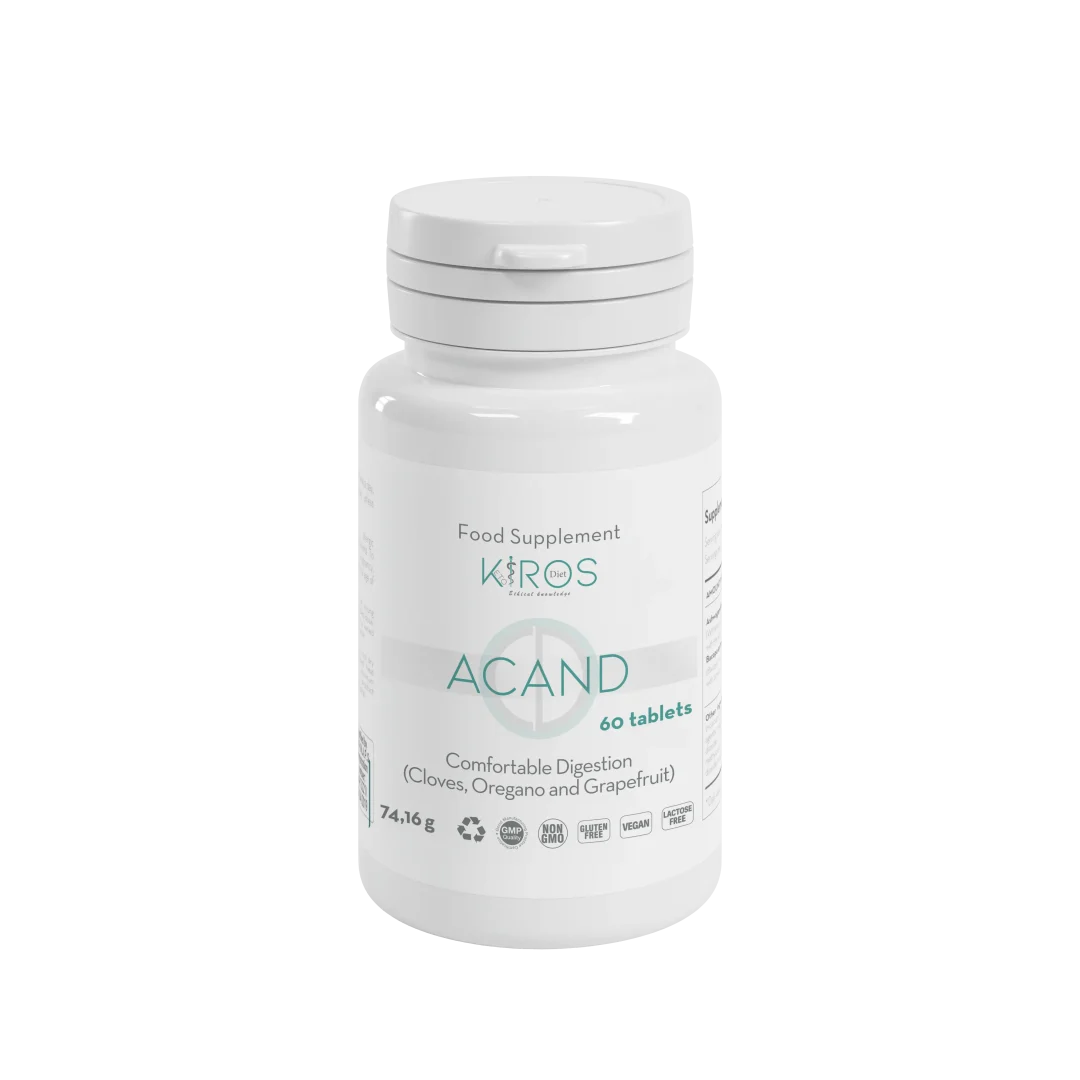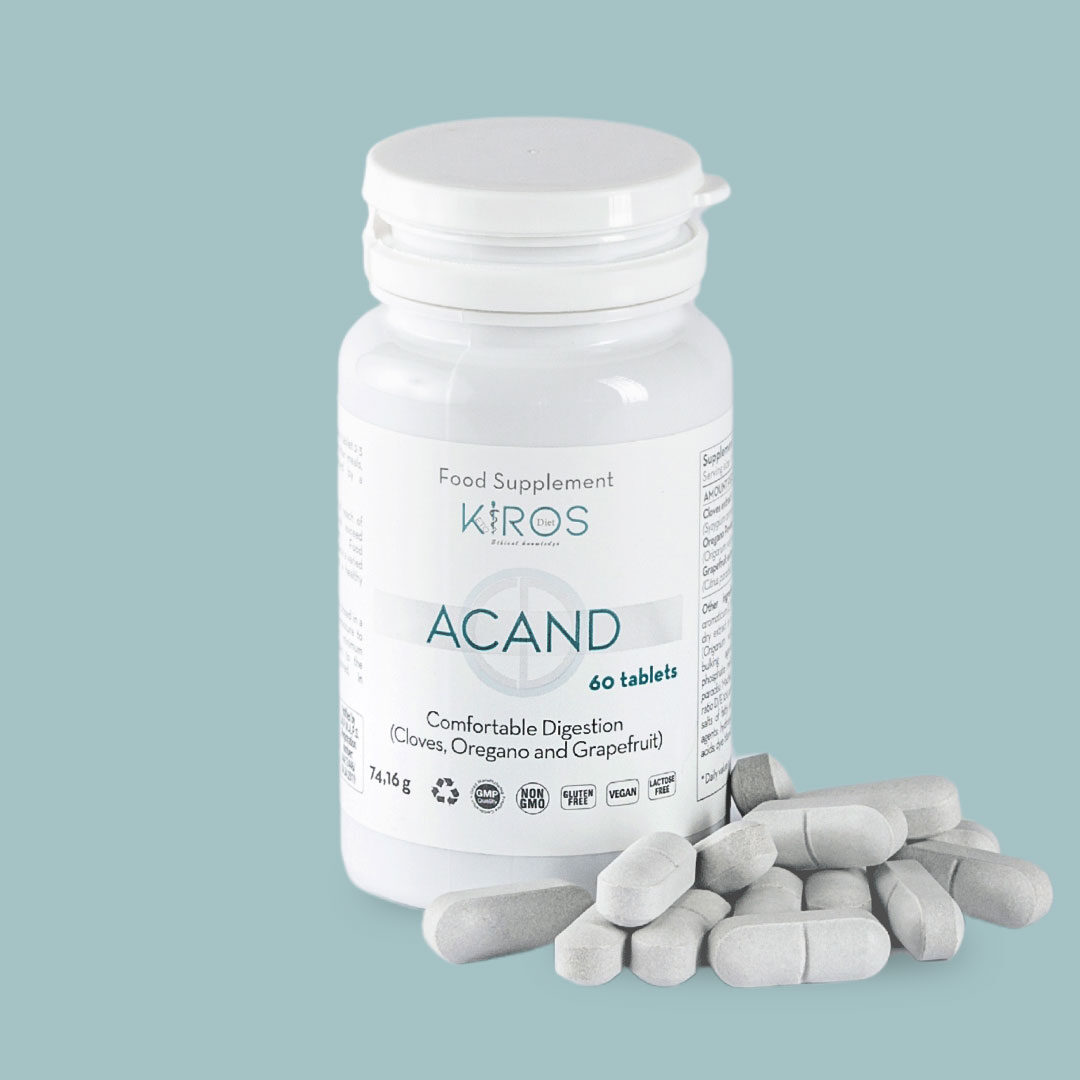EFFECTIVENESS
RE:FRESH. A biologically active dietary supplement, it is an herbal preparation with rebalancing and rejuvenating effects: Triphala, an Indian Ayurvedic preparation and the extract of the millennial Chinese mushroom Ganoderma lucidum. Useful in all cases of reduced dietary intake or increased need for useful components to improve gastrointestinal health and the intestinal and skin microbiota. Promotes efficient digestion, absorption, elimination and rejuvenation.
One capsule of RE: FRESH is able to provide 750 mg of Triphala and 200 mg of Ganoderma lucidum. The particularly balanced formulation seems to play a positive role in psycho-physical balance, with plants of proven activity and great tradition such as Triphala and Ganoderma extract. The formula is able to improve gastrointestinal health, helping in case of constipation, abdominal pain, hyperacidity and flatulence and stimulate beneficial bacteria in the intestine and skin with anti-aging and rejuvenating action.
BACKGROUND
Human skin is the vital organ of the body constantly exposed to abiotic oxidative stress. Normally about one billion bacteria present per square centimeter of skin including glandular ducts and hair bulbs3 are intimately linked to the well-being of the individual and the onset of pathologies. The skin microbiota has a protective function of the skin, acting as a physical and immunological barrier that hinders the development of harmful bacteria by creating an environment hostile to their development. A balanced bacterial flora ensures the good health of the skin, which is able to regenerate more easily, aging more slowly.It is important to maintain a balanced composition of the microbiota in order to avoid the colonization of unwanted bacteria. When this balance is broken, inflammatory problems, infections, allergies or autoimmune diseases appear.
RE: FRESH maintains the correct secretions of the endocrine system responsible for maintaining proper homeostasis in the body and supporting vital physiological processes by rebalancing the intestinal and skin microbiota. Triphala, an Ayurvedic formulation based on three fruits, is one of the most important rasayana medicines used in traditional Indian medicine. Protective effects on facial skin have been reported. In some studies Triphala increased the synthesis of collagen I, involucrin and filaggrin and showed properties of tyrosinase and melanin inhibition in a dose-dependent manner1. Daily use of Triphala promotes normal appetite, good digestion, prevents senescence and aging, and increases immunity. Regular consumption of Triphala has been shown to improve skin complexion and provide cosmetic benefits.
RE:FRESH is rounded out with Ganoderma lucidum a famous medicinal fungus cinase, found in traditional Chinese medicine and used for millennia. Ganoderma polysaccharides (GL-PS), help the immune system and have significant antioxidant effects, fighting the effects of skin and mental aging as it enhances memory and learning.
CHARACTERISTICS OF COMPONENTS
Triphala is constituted by fruits of the vegetable species Emblica officinalis (Amalaki), Terminalia bellerica (Bibhitaki) and Terminalia chebula (Haritaki), mixed in equal proportions according to the preparation used for centuries in traditional Indian medicine for intestinal cleansing, detoxification and as an immunostimulant. The three plants have numerous biological properties such as helping the body to eliminate toxins, strengthen and stimulate the action of the liver, help the correct functionality and intestinal motility by relieving constipation and reducing meteorism. Obviously in combination they play synergistic action exponentially improving the therapeutic potential.
Triphala is considered a preparation based on tridosic herbs with rebalancing and rejuvenating effects. The name Triphala, mentioned in the ancient Indian Ayurvedic texts, is a Sanskrit word and means “three fruits”, each of which already has fabulous properties individually but which combined take on exponential strength and healing characteristics: Emblica officinalis (Amalaki), Terminalia Chebula (Haritaki) and Terminalia Bellerica (Bibhitaki). The recipe for this traditional herbal supplement dates back thousands of years and is mentioned in traditional Indian texts. The formulation is used for colon cleansing and rejuvenation. It has been used for years to remove fecal matter from the body, preventing the formation of toxins, rebalancing the intestinal and skin microbiota. in particular Triphala inhibits intestinal Candida, helps stimulate bile flow and contraction of intestinal smooth muscles that generate peristalsis, prevents bloating. Several studies have demonstrated Triphala’s potential as a therapeutic agent for weight loss and body fat reduction.
The main constituents of Triphala are tannins, gallic and ellagic acid derivatives, and chebulinic acid, potent antioxidants with activity5-7. Triphala contains numerous other bioactive compounds such as flavonoids (quercetin and luteolin), saponins, anthraquinones, amino acids, fatty acids and various polysaccharides6. These compounds are synergistically responsible for the intestinal and hepatoprotective effects of Triphala. Triphala polyphenols such as chebulinic acid are transformed by the human intestinal microbiota into bioactive metabolites, which have shown strong potential in preventing oxidative damage2. The nutritional aspect is mainly due to the high content of vitamin C, Amalaki is an excellent source of vitamin C and represents the most concentrated and bioavailable source of vitamin C in the plant kingdom. Triphala has a physiological emollient and lubricating intestinal action with active principles capable of stimulating the secretion of bile and peristalsis.
Ganoderma lucidum in China is known , in China as “Ling zhi” whereas in Japan it is known as “Reishi”. In these two countries it is however considered the “mushroom of immortality” because of its officinal properties. It is the most known among the officinal mushrooms, known for thousands of years to the traditional oriental medicine, which included it, in the ancient herbals, as the most effective natural remedy. In the traditional Chinese medicine it is used in the treatment of many pathologies and as a metabolic activator, it contains active principles able to regulate the level of cholesterol, glycaemia and to act positively on cardiac arrhythmia1. Many scientific studies have highlighted the properties of Ganoderma, identifying, within it, a great number of beneficial substances for the body. Ganoderma contains numerous antioxidant active principles such as polyphenols, flavonoids, vitamin C, which neutralize the damage caused by free radicals, the organic germanium that helps mitochondrial activity and cellular oxygenation, which means it helps to fight the effects of aging and enhance memory and learning. Still triterpenes with adaptogenic action but also hepatoprotective and hypocholesterolemic and antitumor9,10Beta-glucans, polysaccharides and glycoproteins with immunomodulatory functions. In particular, the immunomodulatory protein called ling zhi-8 (LZ-8)11 related to an ancestral protein of the immunoglobulin superfamily. The polysaccharides of G. lucidum show regulatory capacities towards the immune system, resulting in antitumor and antioxidant effects12-14 . Ganoderma extract has been shown to protect against oxidative stress following intense exercise15, also regulates gene expression in aging skin cells and induces cytokine secretion, suggesting potential anti-aging effects15
For the first time, a preparation based on such a combination of herbs and active ingredients is proposed and marketed.
LITTERATURE
- Varma, S. R., Sivaprakasam, T. O., Mishra, A., Kumar, L. S., Prakash, N. S., Prabhu, S., & Ramakrishnan, S. (2016). Protective effects of triphala on dermal fibroblasts and human keratinocytes.PLoS One, 11(1), e0145921.
- Yun TK: Update from Asia. Asian studies on cancer chemoprevention. Ann N Y Acad Sci. 889:157–192. 1999. View Article : Google Scholar : PubMed/NCBI
- Sliva D: Cellular and physiological effects of Ganoderma lucidum (Reishi). Mini Rev Med Chem. 4:873–879. 2004. View Article : Google Scholar : PubMed/NCBI
- Dudhgaonkar S, Thyagarajan A and Sliva D: Suppression of the inflammatory response by triterpenes isolated from the mushroom Ganoderma lucidum. Int Immunopharmacol. 9:1272–1280. 2009. View Article : Google Scholar : PubMed/NCBI
- Lu, K., Chakroborty, D., Sarkar, C., Lu, T., Xie, Z., Liu, Z., & Basu, S. (2012). Triphala and its active constituent chebulinic acid are natural inhibitors of vascular endothelial growth factor-a mediated angiogenesis. PLoS One, 7(8), e43934.
- Belapurkar, P., Goyal, P., & Tiwari-Barua, P. (2014). Immunomodulatory effects of Triphala and its individual constituents: a review. Indian journal of pharmaceutical sciences, 76(6), 467.
- Lee, H. S., Won, N. H., Kim, K. H., Lee, H., Jun, W., & Lee, K. W. (2005). Antioxidant effects of aqueous extract of Terminalia chebula in vivo and in vitro. Biological and Pharmaceutical Bulletin, 28(9), 1639-1644.
- Paterson, R. R. M. (2006). Ganoderma–a therapeutic fungal biofactory. Phytochemistry, 67(18), 1985-2001.
- Chen, Y., Xie, M. Y., Nie, S. P., Li, C., & Wang, Y. X. (2008). Purification, composition analysis and antioxidant activity of a polysaccharide from the fruiting bodies of Ganoderma atrum. Food Chemistry, 107(1), 231-241.
- Paterson, R. R. M. (2006). Ganoderma–a therapeutic fungal biofactory. Phytochemistry, 67(18), 1985-2001.
- Tanaka, S., Ko, K., Kino, K., Tsuchiya, K., Yamashita, A., Murasugi, A., … & Tsunoo, H. (1989). Complete amino acid sequence of an immunomodulatory protein, ling zhi-8 (LZ-8). An immunomodulator from a fungus, Ganoderma lucidium, having similarity to immunoglobulin variable regions. Journal of Biological Chemistry, 264(28), 16372-16377.
- XiaoPing C, Yan C, ShuiBing L, YouGuo C, JianYun L and LanPing L: Free radical scavenging of Ganoderma lucidum polysaccharides and its effect on antioxidant enzymes and immunity activities in cervical carcinoma rats. Carbohydr Polym. 77:389–393. 2009. View Article : Google Scholar
- Xu Z, Chen X, Zhong Z, Chen L and Wang Y: Ganoderma lucidum polysaccharides: Immunomodulation and potential anti-tumor activities. Am J Chin Med. 39:15–27. 2011. View Article : Google Scholar : PubMed/NCBI
- Shi M, Zhang Z and Yaang Y: Antioxidant and immunoregulatory activity of Ganoderma lucidum polysaccharide (GLP). Carbohydr Polym. 95:200–206. 2013. View Article : Google Scholar : PubMed/NCBI
- Zhao Z, Zheng X and Fang F: Ganoderma lucidum polysaccharides supplementation attenuates exercise-induced oxidative stress in skeletal muscle of mice. Saudi J Biol Sci. 21:119–123. 2014. View Article : Google Scholar : PubMed/NCBI
